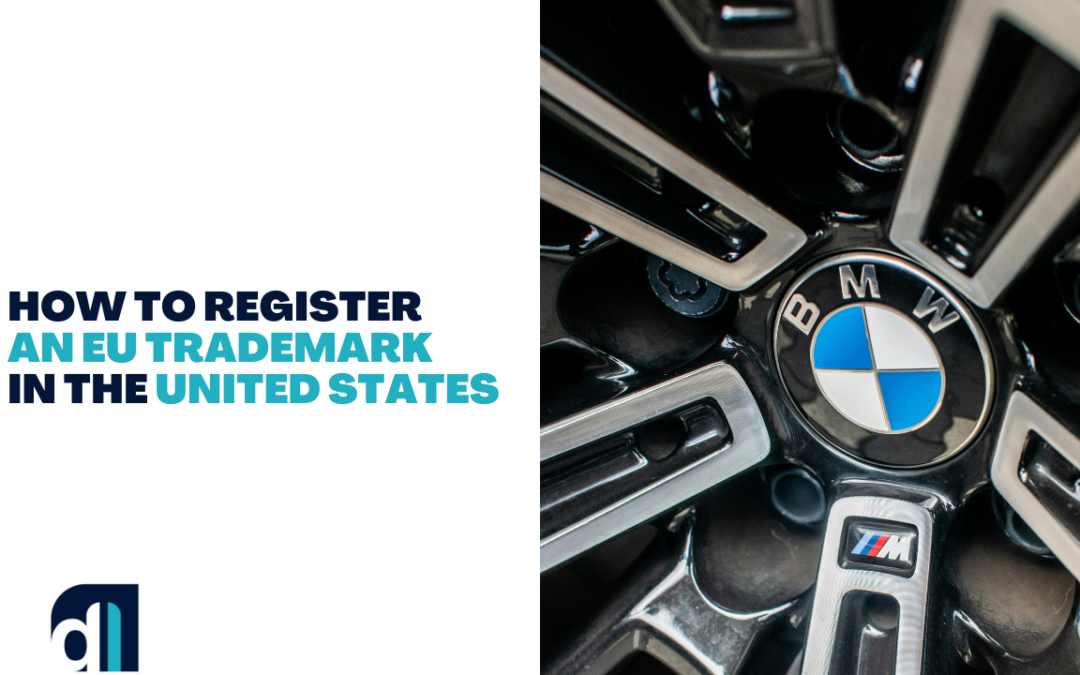Brand protection in the global market is very important when it comes to business expansion and safety in the modern world market.
Although it is possible to obtain a trademark within the European Union which provides protection across all of the member states, it does not extend to the United States, an important market for many companies.
If you have an EU trademark and you are interested in protecting your brand in the United States, you need to register your trademark with the United States Patent and Trademark Office (USPTO).
This guide will take you through the process of registering your EU trademark in the US and protecting your brand in one of the biggest economies in the world.

Why Should One Register the EU Trademark in the US?
Filing your EU trademark in the United States can greatly improve the global security of your brand and its markets.
The US is one of the largest consumer markets in the world, and thus extending your trademark protection to this country can avoid possible legal disputes with competitors. When you get a US trademark you are in a position to protect your brand from being used by others in the region since you are offered a legal basis to protect it.
Also, having a registered US trademark improves the credibility of your business. Trademark laws of the US may work to make your brand appear legitimate and trustworthy to consumers and potential partners when guarded by the law.
This means that to protect your brand identity as you expand across borders it is important to register your EU trademark in the US.
Key Differences between EU and US Trademark Systems
Despite the fact that both the EU and the US have systems meant for the protection of trademarks, there are some differences. Trademarks are dealt with under the European Union Intellectual Property Office (EUIPO) and the registration of the trademark is valid in all the member countries of the EU.
This makes it easier to do so and it also enables businesses to protect their brand in many countries by using one application.
On the other hand, the US has its trademark regime administered by the United States Patent and Trademark Office (USPTO).
The main distinction is that the US has a “first-to-use” system which means that in most cases the first user of a trademark gets the right to it not the first registrant. This is different from the EU regulatory first-to-file system that gives priority to the first applicant irrespective of the use.
Another difference is that the US demands proof of use. Unlike in the EU, it is not necessary to prove the use of the trademark at the outset and instead, US trademark applicants must either provide evidence of use of the mark in commerce or file an intent-to-use application, in which the applicant identifies that they intend to use the mark commercially within a certain period.
It is very important to understand these differences in order to pass through all the steps of registering your EU trademark in the US.
Can One Simply Transfer or Extend an EU Trademark to the US?
As much as it is good to note that there is no direct way through which one can transfer or extend an EU trademark to the US. If a trademark is registered with EUIPO, it means that it is only protected in the EU member countries and not in countries outside this union, for instance, the USA.
However, if you have an EU trademark and you want to protect it in the US, you must apply for a new application in the United States Patent and Trademark Office.
However, as has been previously mentioned, the Madrid Protocol, an international treaty, enables the applicant to apply for the registration of trademarks in several countries through a single application; yet, the US and EU are recognized as two separate jurisdictions.
However, even with the Madrid Protocol, a separate registration in the US is still necessary; although the process can be streamlined if your EU trademark is used as a basis for the application.
You can either directly apply for a trademark in the USPTO or through the Madrid Protocol to get the trademark protected in the EU in the US but you have to meet the criteria set by the US such as proving that the trademark is in use in commerce.
Registration procedure for an EU trademark in the US
To register your EU trademark in the US, the steps you will take will have to meet the requirements of the US trademark law.
Here is a guide that will assist you in going through the process step by step.
Search Trademark in the United States of America
A trademark search must be conducted from the trademark database in the US before filing to ensure that the mark being used is not used by someone else.
The US uses the first-to-use system, so if someone else uses a similar mark to the one you have registered in commerce, they pose a threat to your registration. Look for any conflicts on the USPTO’s Trademark Electronic Search System (TESS).
A comprehensive search aids in the avoidance of some legal problems in the future and increases the likelihood of a successful registration.
Learn how to prepare and file your US Trademark Application
After you are sure of the uniqueness of your trademark, you can proceed to apply for a trademark at the United States Patent and Trademark Office. You’ll need to provide information such as:
-
- The actual symbol or the term that is being used to brand a product or a service.
- The actual symbol or the term that is being used to brand a product or a service.
-
- What the mark will cover: goods or services (must be related to an EU trademark).
- What the mark will cover: goods or services (must be related to an EU trademark).
-
- For the latter, an application must be supported by proof of use in commerce or an intent-to-use application depending on whether the mark holder is currently using the mark in the US. Applications can be filed directly from the home page of the USPTO website.
Answer USPTO Office Actions
When you have filled out your application, the USPTO will examine it. In this process, you may get an office action, which is a communication to you from the USPTO informing you why your application appears not to be in order legally.
Some of the most frequent reasons for refusal may be the conflict with the prior trademarks or the technical defects of the application.
Publication & Opposition Period
After your application is granted by the USPTO, it will be published in the Official Gazette, an online newspaper that informs the public of a pending trademark.
Within 30 days, other people can also file an opposition if they feel that your trademark would be detrimental to their interests. In case no opposition is filed or if any opposition is disposed of then your application will go to the next level.
Trademark Registration
After the opposition period has been completed your application has been accepted you will be issued with a trademark registration certificate from the USPTO.
This certificate entitles you to the use of the trademark in the United States for the goods or services stated in the application.
A trademark attorney can be important at this stage in order to make sense of legal issues involved in the case.
Common Mistakes to Avoid When Registering an EU Trademark in the US
To register an EU trademark in the US, you have to follow several steps, and if something goes wrong, then your registration can be delayed or prevented.
It is therefore important to have knowledge of some of the most common pitfalls that one should avoid.
Presuming EU Trademark Protection Applicable in the US
The first misconception that people tend to have is that having an EU trademark means that it will be protected in the US as well.
Since the EU and the US are two different legal systems, trademark protection in one country does not mean protection in the other country.
This is the biggest mistake that people make
There is a need to search for the trademark before applying in the US. If you have your mark registered and protected in the EU, there can be a person in the US using a similar or the same mark.
The US trademark system is ‘first to use’ and this makes your application vulnerable to prior use in commerce irrespective of your EU registration.
Failure to Comply with the “Proof of Use” Rule
The US wants the applicants to demonstrate that their trademark is in use in commerce or that the applicant has a good faith intent to use it.
Some of the EU companies have not been conversant with the fact that it is not enough to file an application without proving its use.
If you have not been using the mark in the US, you can file an “intent to use” application which is also acceptable but be ready to prove use within the period set by the USPTO.
Misplacement of goods and services
Another common mistake is to mistakenly define the goods or services that your trademark will protect. The US and EU have different classifications for goods and services, thus the classifications listed in your US application for the goods or services should match those of the goods or services to be rendered in the US.
Neglecting Trademark Maintenance
Once your trademark is registered in the US, the work is not over. You must maintain your registration by filing renewal documents and proof of continued use at regular intervals.
Neglecting these requirements can lead to the cancellation of your trademark, leaving your brand vulnerable to infringement. Keep a schedule of all necessary renewal deadlines to ensure your trademark remains in good standing.

Advantages of having US & EU Trademark
Obtaining trademark registration in both the United States and the EU has many benefits for companies interested in going global. Here are the key benefits of having trademarks registered in both regions:
Broader Market Reach
The USA and the EU are two of the largest economic regions in the world and by protecting your brand in both markets, you can reach more customers.
Having trademarks in both jurisdictions is beneficial because it strengthens your position within these important markets, and allows your business to grow beyond that region without the constant threat of infringement or legal issues.
Stronger Legal Protection
Trademarks put you in a legal position to protect your brand against misuse, trademark infringement as well as dilution.
When you have trademarks in both the US and the EU, you have the legal means with which you can defend yourself in case a competitor decides to emulate your brand in either territory.
Enhanced Brand Credibility
Having registered trademarks in the US and EU can help to elevate the status of your company’s brand. Many of them may perceive trademark registration as a sign of professionalism and credibility of a potential trademark holder.
Trademark protection in two of the largest global markets means customers view your business as experienced and reputable, and more business will follow.
Easy Globalization
As soon as you have established protections for your brand in the United States and the European Union, it becomes easier to venture into other international markets.
Trademark protection in these two areas can be used as a base for further registration of trademarks in the world.
If your business intends to expand to other markets, and you intend to target markets that are members of the Madrid Protocol, obtaining both US and EU trademarks will be beneficial for the Madrid application process.
Easier Enforcement of Your Rights
If someone infringes on your brand, having trademarks registered in both the US and EU allows you to take immediate legal action in either region. Without this protection, enforcing your rights becomes more complicated and expensive.
Dual registration ensures that you have the legal standing to pursue infringers and stop unauthorized use of your trademark in both markets.
If you have any questions about registering your European trademark in the United States, please feel free to call 773-234-1139 to set up a free consultation. Our experienced lawyers at Drishti Law will explain and assist you with trademark registration in the United States of America to offer maximum protection to your brand.

Sahil Malhotra
Sahil Malhotra is an Intellectual Property Attorney, who founded Drishti (“vision”) law because of his vision in protecting dreams and ideas.
He provided individuals and small businesses with an opportunity to enhance their IP’s value by helping them register trademarks and successfully argue against office actions. In addition to his training and experience, he has been deeply involved in the multifaceted IP portfolio at UIC and continues to be associated with IP organizations and conferences.
To know more about Sahil Malhotra — Click Here
You may follow Sahil Malhotra on Facebook: Sahil Malhotra and on Instagram: @Sahil Malhotra

